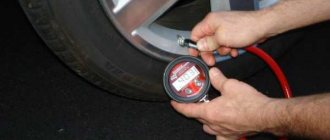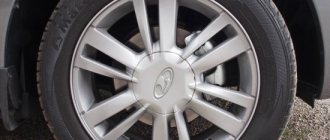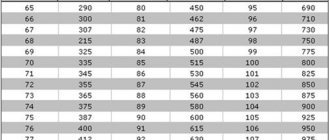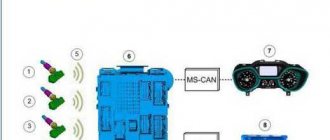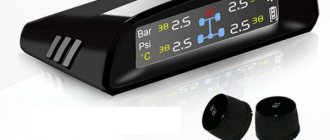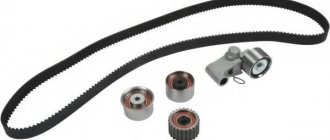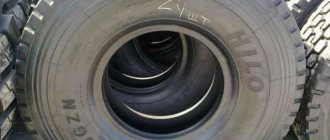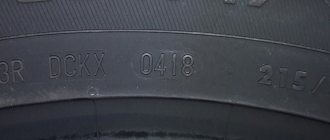Green Dot on a Goodyear Tire – Color Marks on Tires, What Do They Mean?
When buying a new set of tires, car enthusiasts notice various colored marks on the surface of the tires.
At the same time, not everyone knows what information is hidden in these markers. On the Internet you can come across different interpretations of multi-colored signs on a tire, where it is stated that this is a purely technological designation or marking of a defective product that has not passed factory quality control.
At the same time, it is necessary to realize that the designation applied to the surface of the tire using paint cannot be durable during the operation of the rubber. Consequently, the relevance of the information contained in it remains exclusively until the moment the tire is mounted on the rim of the car wheel. Let's look at the main types of colored marks applied to the rubber of modern cars.
Yellow dots or triangles
Yellow markers in the form of a small triangle or spot with a diameter of 5-10 millimeters are applied by the manufacturer to the side surface of the tire, in its lightest place, which is determined in the factory by the balancing method.
During installation, the place marked in this way should be located opposite the “L” symbol shown on the disk (light zone of the rim), and if there is none, it should be aligned with the inflation valve (nipple).
These recommendations will allow the assembled wheel to be balanced as much as possible, which will require fewer compensating weights during balancing.
It is clear that the difference in the weight of individual zones of the wheel is insignificant, and therefore the relevance of the yellow dot as a result of active use of the tire disappears even before repeated tire fitting.
Red dots and triangles
By analogy with the previous mark, the red one indicates the most rigid, and therefore the heaviest, area of the tire side wall. Accordingly, it is located on the side, and should be aligned with the letter “L” on the disk, or be located opposite the nipple.
Red marks are most often found on tires supplied as the original equipment of the vehicle. It should be noted here that the discs from the original kit have a marking (white dot), which should be aligned with the scarlet markings.
One more nuance regarding the above-mentioned markers. When installing wheels, drivers are advised to follow the yellow marks only, aligning them with the nipple, and ignore the red marks, which are intended for correct installation of rubber on the rim at the factory.
White stamp with a number
A white mark in the form of a circle, triangle, rhombus or square with a number inside, located on the sidewall of the tire, is an analogue of the Quality Control Department sign, known to ordinary people since the times of the Soviet Union.
Its presence indicates that the product has passed final quality control at the enterprise and fully complies with the declared characteristics.
Among other things, this stamp indicates a specific company employee who is responsible for the reliability of the quality control of the finished tire.
Multicolored lines
Colored lines on the tire tread are intended to identify the sizes and models of tires stacked in racks or pyramids in the warehouse.
Rubber of a specific size is marked with stripes of a unique color, width and location, which makes it much easier for warehouse workers to recognize the desired product among many similar ones.
In addition, multi-colored lines serve as an indicator by which you can determine whether the tires have been run-in.
White circle or dot
Some tire manufacturers apply markers in the form of a circle or a white dot on their products intended for the original equipment of cars.
The place where such a sign is applied is the point of minimum deviation of the radial force. In other words, this is the most flexible part of the tire sidewall.
When assembling the wheel, this marker should be located opposite the letter “L” on the disk, or aligned with the “upper” mark on the wheel.
wheel-info.ru
What do the multi-colored dots on the sidewalls of tires and the stripes on the tread mean?
Yellow and red marks on tires.
What do they mean: 1. Multi-colored dots, triangles, which are applied to the sidewalls of car tires?2. Colored stripes on their tread?
The answer to this curious question is quite simple. Circles (dots, triangles) of red, yellow color (blue or even white designations are also found) are nothing more than balancing marks and they are intended to ensure the most accurate balancing of a car wheel.
1. Yellow dot, or yellow triangle.
This yellow dot (or yellow triangle), which is marked on the sidewall of a car tire, is the lightest part of the tire , which is determined by the static balancing method.
If the rim has a visible marking “L” - this is the lightest place on the rim, then during installation it is necessary to place the lightest place on the rim (“L”) on the opposite side from the lightest place on the car tire , that is yellow dot.
Note: 1. “L” is the lightest place on the rim. 2. On wheel rims from different companies, it can be indicated by different colored dots: green, blue, and also other colors.
If there is no visible marking “L” or colored dots on the rim, then during installation it is necessary to combine the heaviest place on the rim, and this will be the place where the inflation valve is located with the lightest place on the car tire, that is, the yellow dot .
2. Red dot, or red triangle.
This designation indicates the maximum point of radial force deflection (RFV), and thus is the stiffest and therefore heaviest point of the sidewall of a car tire.
When mounting the wheel, this point must be aligned with the “L” mark - this is the lightest place on the wheel rim. The red dot (triangle), as a rule, is applied to car tires that are supplied in the original (primary) configuration of the car. Its purpose is the greatest power heterogeneity.
In other words, this is a kind of heterogeneity, the occurrence of which can be closely related to various kinds of connections of various layers of a car tire (breaker layers, carcass layer, and so on).
Wheel rims that are supplied as part of the vehicle's original equipment are also marked with the minimum distance from the center of the rim to the rim (a white dot or other mark is applied).
When a car wheel is assembled at a car factory, the red dot on the tire is aligned with this mark on the rim.
This is done in order to reduce the maximum power heterogeneity, to ensure a balanced power characteristic of the wheel assembly.
During normal wheel installation, experts recommend not paying attention to the presence of the red dot, but only be guided by the yellow dot when aligning it with the inflation valve.
3. White dot or white circle.
In the case of some OEM tires, this color marking indicates the radial force deviation (RFV) point, which is the most flexible part of the tire's sidewall. In this case, the white dot or circle should be aligned 180° from the 'L' mark, or the "top" mark on the wheel.
4. Multi-colored lines.
The multi-colored lines that are printed on the treads of car tires are necessary to distinguish between these tires that are in a stack, for example, in a store or in a warehouse.
Each size of car tire is endowed with its own unique color, location and thickness of these colored stripes.
Stripes can sometimes vary depending on the state of the manufacturer, the specification and date of manufacture of car tires, and even on tires that have the same tread pattern and size.
According to foreign experts: colored lines serve as an indicator on the tire, which shows that the tire has been run-in.
5. White stamp with a number on a car tire.
A white stamp with a number on a car tire indicates the number of the inspector who carried out the final inspection of the car tire at the factory. In addition, this digital marking does not carry any information load.
Car owners who purchase car tires in retail stores are advised to first pay attention to the relevant inscriptions that are present on the sidewall of the tire: size, speed symbol, load index, country of manufacturer, tread pattern, specification, and so on .
The colored stripes on the treads of car tires carry only internal factory meanings and should not be taken into account in any way by ordinary buyers.
bm-auto.ru
What do the colored marks on tires mean?
Buying new tires is always a responsible matter. In addition to selecting the ideal combination of price and quality, we often get lost in newfangled characteristics, indicators and labels. For example, these could be multi-colored marks on tires.
You've probably seen marks of different diameters, shapes and colors on wheels.
What did these marks on the tires mean? You will find answers to this question in this article, which talks in detail about the need and reasons for applying color markings on tires.
Colored (temporary) markings on tires appeared several years ago. However, with the introduction of more and more new characteristics, the presence of such an attribute on tires began to confuse many car owners.
First you need to understand what types of tags there are. In this article we will not cover the markings on tires, since this is a broad topic and the meanings that denote this type of stamping are multifaceted (from rubber composition to technical capabilities).
We will analyze only temporary (since the paint wears off during long-term use and the color of the tire becomes monochromatic) signs and stamps that indicate a special meaning and a separate purpose.
To organize the information, we will divide the most basic types of tire markings into groups, and explain their meanings in detail.
The classic red markings on tires indicate the location of the strongest point on the rubber.
Colored round spots on the side surface
The most common marking that can now be found in stores and warehouses is marking in the form of small round dots. Their size may vary, but as a rule, the diameter of such points is 10-15 millimeters.
In the first tires with similar markers, the dot gave way to a triangle. Such markings do not have any special differences. It's another matter when these dots have a different color palette.
Among the most basic colors found on the market are yellow, red and white.
Source: https://ssangyong-echoauto.ru/raznoe/zelenaya-tochka-na-shine-goodyear-cvetnye-metki-na-shinax-chto-oni-oznachayut.html
Tire markings
There are certain labeling standards that any manufacturer must indicate on the tire.
These inscriptions are printed on the sidewall of the tire and contain information useful to the buyer. The manufacturer, tire model, and size are indicated in large letters. There are two types of sizing: European or American. European markings use the metric system and look like this: 185*45*R17. The first number indicates the tread width, the second indicates the profile height, and the third indicates the internal diameter. The letter R stands for radial cord weave.
One American format is similar to the European one, but there are additional letters in front of the numeric values. For example, LT 195*45*R17. These tire designations indicate their area of application (LT – light track, P-passenger, T – track). This allows you to quickly select the appropriate set.
The second American method uses the inch system. The marking 30*10.5*R17 tells the buyer first about the outer diameter of the wheel (30 inches), tread width (10.5) and inner diameter. This method is the most convenient, because the external dimensions of the tire are indicated.
Special attention should be paid to the mark with the load and speed index on the sidewalls of the tires. These marks are placed next to the wheel size and are indicated by a number and a Latin letter, respectively. Like road signs, such signs convey important information to the buyer. The load index tells you how much weight one tire can support. If there are two values on it separated by a hyphen, this means that the tires can be installed in pairs and the first value indicates the load for a single installation, and the second for a double installation. Additionally, there may be an EL (Extra Load) mark, which indicates a reinforced cord weave and the fact that the load index of such tires is three points higher.
The speed index is denoted by a Latin letter. This marking indicates the speed limits that can be achieved on such tires. Everything is simple here - the closer the letter is to the end of the Latin alphabet, the higher the speed value.
The seasonality of tires is important. Summer tires are not designated in any way - if there are no special pictograms on the sidewall, such tires are considered summer. There may be an additional presence of an umbrella icon, rain, the words Aqua or rain, which indicates a developed pattern that allows you to effectively drain water and resist aquaplaning.
All-season tires are marked with the letters M+S or Mud+Snow. Such rubber feels good at average temperatures, but is significantly inferior to profile sets when deviating from average values. Therefore, it is advisable to have two types of seasonal tires, and consider all-season tires as a “transitional set” .
Winter tires are indicated by a snowflake icon or the letter W (Winter). Such sets consist of soft rubber, which does not harden in the cold and clings well to the surface. The buyer can choose between studded or non-studded tires (Velcro).
A studded set is needed only for harsh winters and frequent driving on icy asphalt. If you live in an urban area, then studless tires are sufficient. Depending on the type of climate, you can give preference to Scandinavian tires (cold, snowy winters) or the European equivalent (mild climates).
It also happens that the tires have additional signs in the form of the inscription Rotation, Outside or Inside, arrows indicating the direction of rotation. Such marks are placed on tires with an asymmetrical and directional pattern and indicate the correct location of the wheel, its outer or inner side. All this makes it much easier to install the tire yourself.
Sometimes you can see different colored stripes on tires. In the form of multi-colored lines, stripes, triangles, squares or seals. These strips carry interesting information about the composition of the rubber compound and provide valuable information for the tire service worker.
Yellow, red, colored marks on tires: what do these dots mean?
Almost all new tires have markings of different colors. Some people simply don't pay attention to them. Others, on the contrary, attach great importance to such marks. Few people know what the multi-colored marks really mean. Let's try to figure it out and understand which of the existing versions are myths and which are reality.
What marks are found on tires and what do they mean?
There are several main theories that explain the origin of the colored marks on new tires. Some people believe that these are technological marks that the consumer should not be interested in. Others are sure that this means defective products or those that have not passed quality control. Let's figure out which of them is right.
If you think logically, you can come to the conclusion: when making marks with paint, the manufacturer understands that they will quickly be erased during use. Therefore, the information conveyed by multi-colored markings on tires is of temporary importance and is important until the first tire fitting.
Most often, the manufacturer applies small round dots with a diameter of 10–15 mm on the side surface of the tire. Their color is usually white, yellow or red. There may be triangles instead of dots, but they have the same meaning.
Yellow mark
The place where a round or triangular yellow mark is applied to the side of the tire is the weakest and least protected.
The yellow mark on the tire indicates the weakest and least protected point
This information is important when installing the tire. The disk has an L-shaped designation indicating the weakest point of the disk.
Correct tire alignment involves placing a mark on the rim on the opposite side of the yellow dot on the tire. The yellow mark is aligned with the heaviest place on the disk, i.e. the nipple.
This is done to ensure that if a strong impact occurs, the tire and wheel are not simultaneously damaged.
red mark
If the yellow mark indicates the weakest point on the tire, then the red mark, on the contrary, is the strongest. In scientific terms, it is applied at the location of the maximum radial force deviation (RFV). During installation, a red mark must be placed near the designation on the disk in the form of the letter L.
The red mark indicates the strongest point of the tire
To understand why weak and strong spots form on a tire, we must take into account that the process of creating it is complex and time-consuming. To obtain the most ideal shape, the tire is made of several layers.
Very rarely the red mark is not opposite the yellow one. When installing tires, it is important that the yellow mark is located as far as possible from the weakest point on the rim.
The red and yellow marks are located opposite each other
White mark
The side of the tire may have a painted white dot or a stippled design. They do this in the most flexible place. The white mark indicates the location where the radial force deflection will be smallest.
The white mark indicates the location where the radial force deflection will be smallest
Yellow and white marks are not always present on the tire at the same time, but you need to keep in mind that they mean approximately the same thing. When carrying out installation, you need to rely specifically on the location of the yellow dot, but if it is not there, we place the white mark 180° from the letter L.
Stamp with numbers inside
If in previous cases the color of the marks mattered, then the stamp can be of any color. There are yellow, blue, and white stamps, but this does not affect the information they carry.
There are yellow, blue, and white stamps; their color does not affect the information they carry
It is not the color that matters, but the number written inside.
This mark indicates that the tire was tested at production and meets the declared quality, and the number indicates the inspector conducting this check.
For an ordinary consumer, such information may only be needed if a defect is detected. Using the stamp, you can find the person who let the defective product go on sale.
Colorful stripes
The tire can have stripes of different colors. They are necessary to simplify the search for tires in the warehouse. Since tires are stored vertically, the strips help warehouse workers identify the manufacturer's production date and other information without removing them from the rack.
Multi-colored stripes on tires make them easier to find in stock
For the buyer, such markings do not convey any information and there is no need to pay attention to them when choosing tires.
: what do the marks on tires mean?
Source: https://bumper.guru/klassicheskie-modeli-vaz/poleznoe/cvetnye-metki-na-shinah.html
What are they for?
First of all, such signs appear in the form of balancing marks, which are necessary in order to carry out the most accurate balancing of the tire with the disk. In addition, what the color marks on tires mean is indicated in the documents defining the methods of production, subsequent marking and use of tires in Russia. However, due to the fact that the GOST regulating this was introduced back in 1984, it does not contain any mention of the colors of such designations.
Often, modern markings used on car tires are small round dots. Typically, the size of such designations is 10-15 mm in diameter. If previously the markings had a triangular shape, today they are predominantly round. But the main differences are now considered to be the different colors used for the designations. The main ones are:
- Yellow.
- Red.
- White.
Colored stripes on the tire
There are even letter designations, as well as various stripes. It is worth examining each of the options in more detail.
Yellow
When such a stamp is applied to the side surface of the tire, this indicates the lightest and also weakest coating in this place , from the point of view of protection. This parameter is easily identified even during static balancing. In addition, such designations are also applied to wheel rims, only in the form of the “L” symbol. Therefore, when beading the wheel, it is recommended to place them in such a way that similar markings on the two elements are in opposite directions. This is required so that in the event of heavy loads due to a collision with an obstacle, there is no damage to two elements at the same time.
Red
A feature of such designations is considered to be an indication of the strongest and most durable place on the tire . In professional parlance, it is called the point where the maximum deflection of the radial force occurs. Red dots are usually installed on new tire models that have not yet been used. Often they try to install it when beading the wheel, flush with the “L” symbol marked on the disk.
The presence of such strengths and weaknesses is due to the manufacturing technology of car tires and the impossibility of perfectly maintaining all proportions. This occurs due to the heterogeneity of the layers that are present in car tires, as well as the complexity of the rubber filling process.
White
In this case, the marking indicates the most flexible place that the tire has. In other words, the white dot, which may be completely colored or has dotted edges, indicates the place on the tire where the least radial force deflection occurs. Similar to the yellow designation, it is recommended to install it as far away from the “L” designation on the wheel rim as possible.
Points on the wheel
Colored stripes
Separately, it is worth mentioning the colored stripes on the tire tread. Long lines are usually present on the entire rim of a car tire. Usually they are applied to the protectors or between them in special grooves. But only the manufacturer needs such tags. They are used to identify the storage index. It has a specific tire that is located for a certain time in the territory of a large warehouse. Simply put, they are used in the form of a kind of barcode, through which the search for the product of interest is carried out. In this case, products are differentiated by color, as well as the thickness of the applied lines. They indicate belonging to a specific batch produced in a certain period.
Numbers
Such markings, applied to the surface of car tires, differ solely in their nominal value. In this case, color or thickness does not play a role, but only actual designations. They indicate the level of inspection that the material (rubber) from which the tire was made was subjected to. By and large, it represents a kind of GOST. The presence of such markings on the surface of the product indicates that the finished product has previously passed a quality test.
Marks are applied to tires in the form of digital values inside a circle. At the same time, they indicate the license plate number of the inspector who carried out the verification process itself, and therefore such information does not provide any benefit to the consumer. If a defect is identified, the designations will help you find the person responsible in production for putting such a product on sale.
The main useful information for motorists is provided exclusively by colored dots applied to the surface of finished products. All other designations are needed only for manufacturers, since they contain internal information about the production and testing of finished products.
Source: tolkavto.ru
Colored marks on tires: features and characteristics
Many car enthusiasts have noticed that some tires have various color markings in the form of circles, lines or other geometric shapes. They are applied in a thin layer, from which we can conclude that the information is relevant only during storage, transportation and tire fitting work.
During driving, such markings are quickly erased. What do the colored dots on tires mean and how can they help a car enthusiast when choosing tires?
Round colored spots
The diameter of such elements does not exceed 10 mm. You can meet them on the side areas of the tread.
They usually come in yellow, red, white and green, but there may also be rarer options, for example, light brown, blue, etc.
They mean the same thing as more common colors (this solution is a way for various manufacturing companies to specially label their products).
Yellow mark on the tire
Indicates the lightest area of the tire (“L”). It is recommended to combine this area with the disc nipple. This way, it will be possible to achieve better wheel balancing without using a large amount of weights when performing tire fitting work. If this is done perfectly accurately, then additional counterweights may not be required at all.
Point L has certain features that you need to know about:
- if this marking is absent, then the lightest area of the tire is determined using the device, for example, as the area opposite the inflation valve (heaviest area);
- different manufacturing companies can mark the “L” point in different colors: blue, green, light brown;
- The marking is necessary only for correct balancing of the wheel, and does not carry any other information that could be useful during the operation of the tires.
Red mark on the tire
In contrast to the yellow dot, this marking is the hardest part of the tire. It is calculated using special instruments. In physical terms, it represents the area of greatest radial force deviation (“RFV”).
The color here is usually static. Only the form of marking can change. Manufacturers often use a triangle instead of the usual circle. “RFV” can be detected on tires that come as standard with the vehicle. At the stage of tire mounting work, this point must be combined with point “L”.
Many Russian and some European brands simply do not apply such markings. In such a situation, it is necessary to perform balancing based solely on the location of the yellow dot.
White mark on the tire
Some tire manufacturers (in addition to the above colored dots on tires) also use white markings. It looks like a white circle or ring on the side of the tread. Unlike the red marking, this location represents the area of least radial force deflection, i.e. the most flexible area of the tire.
https://www.youtube.com/watch?v=E8Dc_cXdDf0
The white dot must be aligned with the “L” marking (180° from it) or with the “upper” mark on the tread.
Numbers enclosed in various geometric shapes
This marking is also applied to the side of the tire. May be in the following colors:
- white;
- yellow;
- blue;
- red.
The marking is a distinctive sign of inspection of the tire by an inspector. This is its serial number, by which you can easily determine who released this tire for rental. If the rubber does not meet the declared quality or a defect is discovered during operation, the company will be able to find the controller who allowed such products to come out.
For the end consumer, this marking does not carry any meaning, so it is not needed either for tire fitting work or for operating the tire itself.
Colored stripes
Similar markings are applied both to the tread and to the side sections of the tire. For ordinary car enthusiasts, such information does not carry any meaning. Colored lines are simply needed at the stage of storage and transportation of products.
Color stripes differ from each other depending on:
- country of origin;
- the company that produced the tire;
- Year of release;
- features of certification;
- separate model range and production series.
Each manufacturer has its own markings that identify its products (like a barcode). Even among individual series and models of tires, color lines are not repeated, because this makes it much easier to find the right batch of tires in the warehouse.
Many experts believe that such lines can be considered a kind of indicator that determines whether a given tire has been run-in or not.
Thus, tire markings are only needed during the storage, transport and transport phases of the wheels. For the average car enthusiast, such information is unlikely to be useful. The marking does not determine the operating characteristics of the tire, and it cannot help in any way with the everyday use of a set of tires.
Source: https://jrepair.ru/interesnoe-na-jrepair-ru/shini/tsvetnye-metki-na-shinakh-osobennosti-i-kharakteristika
WHAT DO THE SYMBOLS ON THE TIRE SIDEWALL MEAN H/P, H/T, A/T, M/T
For all-wheel drive cars and 4x4 SUVs, the following categories of tires can be distinguished.
- H/P (High Performance) - Pure road tires. For driving on asphalt roads. The tires are as close as possible to car tires - for dynamic driving. They are quiet and have good grip on smooth roads. The tread is not high, “racing”.
- H/T (Highway Terrain) - For driving mainly on paved roads. Road tires. The tread is not high, typical for passenger tires. The tire sidewall is poorly protected.
- A/T (All Terrain) - Universal tires for driving both on asphalt and light off-road. The tread is more aggressive than the H/T (higher and grippier), the sidewall is more protected. Designed for asphalt, dirt roads, sand, stone, snow, everyday use. All means that the tire performs well both on and off the pavement.
- M/T (Mud Terrain) - Mud in English means mud - tires for off-road driving. The tread is “like that of tractors”, they have side lugs and are more difficult to clog with dirt. The tires are more oaky than A/T and are not very good on asphalt (don’t drive on the highway), and also behave poorly on ice. Designed for: driving on broken roads, ruts, clay, wetlands.
Decoding color marks on tires
Color markings come in different shades - red, green, yellow, white and indicate the degree of stability and endurance of various loads; by them you can determine the weakest or strongest point of the product.
When purchasing a new set of tires, every detail is important for the driver, which will further affect the quality of work.
Tires can be deciphered according to several criteria, such as size, coating thickness, and the pattern on the tires, but the most interesting question is the color scheme on the treads. Every driver, when purchasing tires, has been faced with the question of multi-colored markings on the surface.
To choose the most suitable set of tires, you definitely need to understand what each color and each symbol means, since the quality of your ride on the roads depends on the correct choice.
Decoding color marks on tires
Some believe that you can read useful information on the label that will help you use the product correctly, but in most cases this is a mistaken opinion. We suggest you understand in detail which symbols and colors are intended for what purpose.
Yellow marks on tires
If you notice a yellow circle or triangle on your tires, you can be sure that this indicates the lightest area of the tire. It is also designated by the letter L. They are used to balance wheels without using additional weights, but subject to absolutely accurate work.
The lightest point has some features:
- If there is no such point, it can be determined with a special device in a car repair shop. The same technique is used as for determining the heaviest area.
- If a yellow mark is not found, then you need to check with the manufacturer, as the color can be changed based on personal preference.
- For an ordinary driver, the mark will not bring useful information; it is only needed for correct balancing and to simplify work in the auto repair shop.
Red symbols
The red icons, taking into account the difference from the yellow ones, indicate the strongest and toughest place on the tire. It can be determined using special devices. Referred to as RFV and represents the area of greatest radial force deviation.
Color is used to indicate hardness across all manufacturers. The geometric shape can be changed - circle, triangle. The scarlet stamp may be for a basic set of tires when you first purchase a vehicle. When working on wheels, specialists combine red and yellow dots in one area.
Since many domestic and foreign manufacturers do not apply such markings, it is necessary to symmetry the wheels based on the location of the L mark.
There is one nuance that you should pay attention to when mounting wheels - pay attention and focus the work only on the indicators of the light points and ignore the latter, which are necessary for installing tires at the factory.
Yellow and red symbols
White indicators on the protectors
In addition to multi-colored markings, tire manufacturers will use white for marking. It is used as a circle or filled circle on the outside of the tire. It determines the most flexible part of the tread, that is, the area of minimal radiation force deflection.
A white ring, diamond or square with a number inside means that the tires have passed the necessary diagnostics at the factory, meet all standards and are ready for use.
The point must be located 180 degrees from the point of the most weightless zone or combine it with the top point.
Color stripes
These indicators are not filled with important information; they are used for transportation and safety. Stamps in the form of stripes are applied in two versions: either on the inside or on the side of the tire.
The stripes differ according to the following criteria:
- Country from which the product was imported;
- The organization that handles the exit;
- Time when produced;
- Product model identifier;
- Features of classification.
Each manufacturer has markings, sizes, and colors of stripes that differ and are not repeated. This is the so-called company barcode. Such designations are made to make it easier to find the desired model and series for the car.
Experts add that such an identifier determines whether the tire has passed factory tests and is ready for sale or not.
What do the numbers in geometric shapes mean?
In most cases, stamps are drawn in the form of various shapes and a number is written inside. You can see it on the side panel of the tire. What colors can there be:
- White;
- Dark blue;
- Shades of red;
- Yellow palette.
Such signs carry information that the tire has been tested by the inspection service and has no contraindications for use. In addition, it indicates which employee issued the tire for rental and, in case of malfunction or problems, will help you find the right controller who allowed the release.
CORRESPONDENCE OF TIRE DESIGNATIONS IN INCHES AND MILLIMETERS
| 7.50R20 | 220R508 |
| 8.25R20 | 240R508 |
| 9.00R20 | 260R508 |
| 10.00R20 | 280R508 |
| 11.00R20 | 300R508 |
| 12.00R20 | 320R508 |
| 14.00-20 | 370-508 |
The designation for bias-ply tires is similar to that for radial tires.
There is a tire designation based on overall size.
For example: 530/70-21 (1300x530-533) – Kama-410


